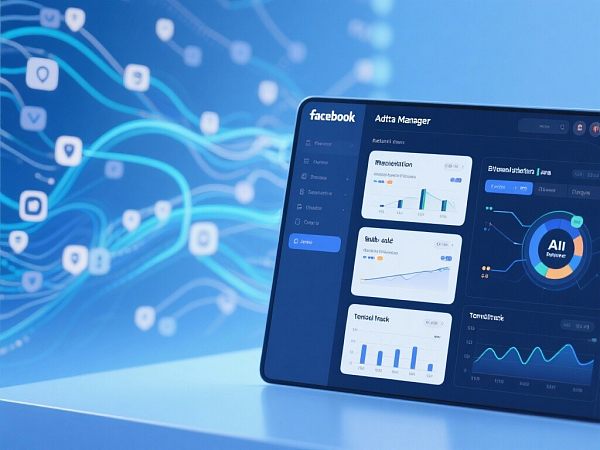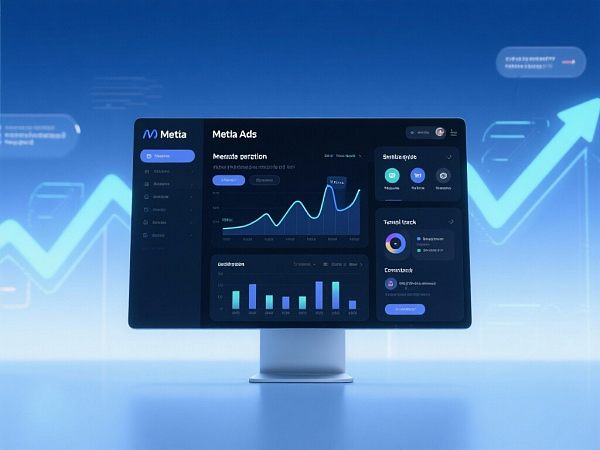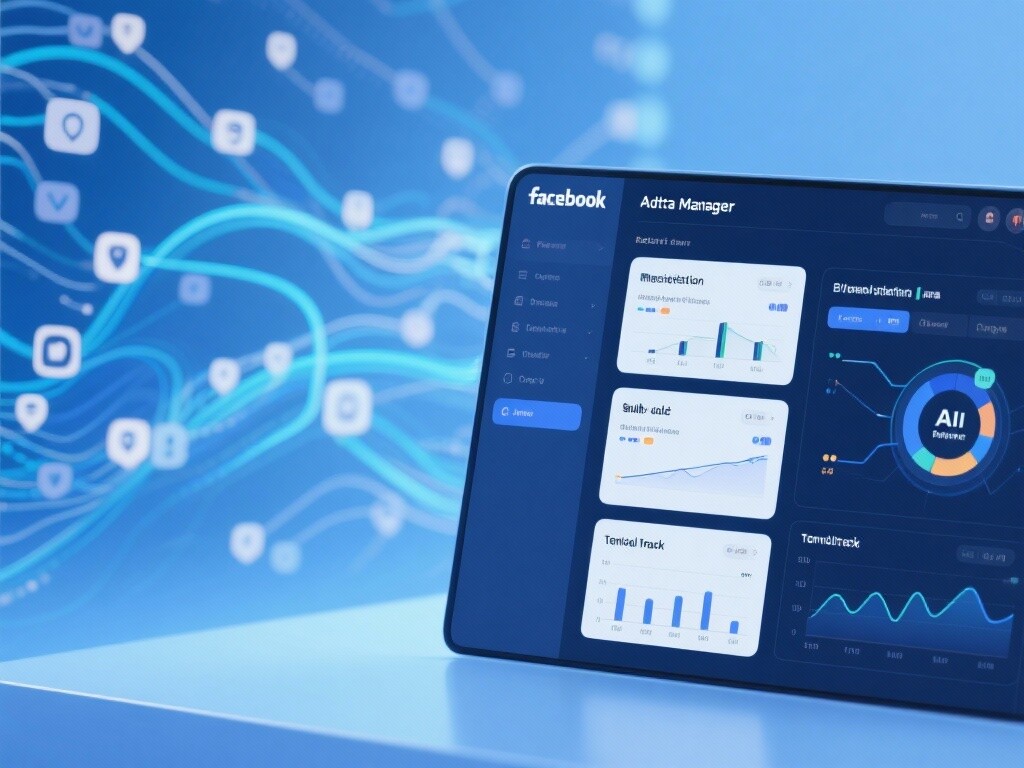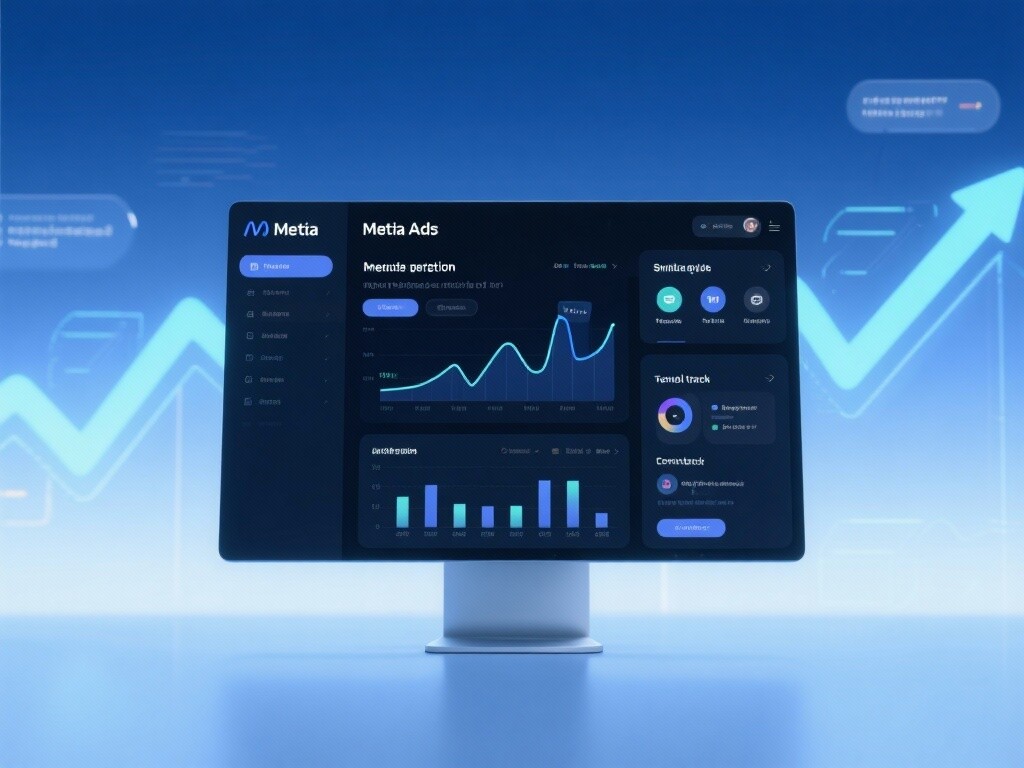Easy Camp Cloud Intelligent Website Construction and Marketing System Platform!
Facebook advertising is defined as a social marketing system centered on user data.
Facebook Ads (Facebook Ads / Meta Ads) refers to the process by which advertisers use Meta's Ads Manager platform to display paid content to its vast user base (including users of Facebook, Instagram, Messenger, and Audience Network). Its core lies in leveraging the massive amounts of user data accumulated by Meta to achieve precise audience targeting and goal-oriented automated optimization .

The three core pillars of Facebook advertising:
Precise targeting: Achieving highly segmented audience reach based on demographics, interests, behaviors, and custom audiences (such as Lookalike Audience).
Objective-Driven: Advertising campaigns must be set up around clear business objectives (such as brand awareness, traffic, conversion, and app installs).
Smart Bidding: Using Meta's AI algorithm, within budget constraints, it automatically finds users most likely to achieve predetermined goals (such as purchasing or adding to cart) and bids on them.
The essence of Facebook advertising: Discovery marketing that combines "people finding content" and "content finding people".
The evolution of Facebook advertising: from simple banners to AI-driven conversion engines
The history of Facebook advertising is a process of continuous evolution around user data, mobile devices, and automation trends, with its core being the continuous improvement of ad relevance and conversion efficiency .

1. Early Stage: Simple Banners and Right Sidebar Ads (2004-2010)
Technical features: The advertisements are mainly displayed in the form of banners and text links in the right sidebar . The positioning is simple and is mainly based on user profile information (such as age and gender).
Limitations: Low ad relevance, low click-through rate (CTR), and the primary goal is brand exposure .
2. Mobile, Feed, and Native Advertising (2010-2015):
Key shift: With the widespread adoption of smartphones, Facebook moved mobile-first . Ads were integrated into users' **News Feed**, mimicking native content and increasing user acceptance.
Data-driven: The launch of Facebook Pixel allowed advertisers to track off-site conversion data, ushering in the era of performance marketing.
3. The Revolution of Algorithm Optimization and Smart Bidding (2015-2020):
Core technology: Introducing intelligent bidding strategies based on machine learning (such as minimum cost and target cost) to give AI the power to make advertising decisions.
Audience Deepening: **Lookalike Audience** has become a core tool for high conversion rates.
4. Privacy Challenges and the CAPI Era (2020 to Present):
Challenge: Apple's iOS 14.5 update and other privacy policy changes have limited Pixel tracking in browsers.
Response: Meta launched the Conversions API (CAPI) to encourage advertisers to use server-side tracking to ensure that the advertising system can still obtain accurate conversion data and maintain the efficiency of smart bidding while protecting privacy.
The technical principles behind Facebook ad serving: AI auctions and data feedback loops
The effectiveness of Facebook ads relies on its sophisticated AI auction system and closed-loop data feedback mechanism .

1. Advertising Auction Principles: Total Value Mechanism
The winner of a Facebook ad auction is not always the highest bidder, but rather the ad with the highest total value .
Bid: The maximum amount an advertiser is willing to pay (automatically adjusted by AI in smart bidding).
Estimated Action Rate: Meta AI estimates the likelihood that a user will take the expected action (such as purchasing, adding to cart, or clicking) after seeing an ad. This is the most critical factor , determined by historical data.
Quality & Relevance Score: Based on user feedback to ads (such as whether they are hidden, shared, and the interaction rate).
Key takeaway: High-quality, highly relevant ads can win auctions with lower bids because they have higher predicted action rates and higher total value.
2. Core Technologies: Meta Pixel and Conversions API (CAPI)
Meta Pixel (browser-side): A piece of JavaScript code installed in the website's codebase. It sends website visit, add-to-cart, and purchase data back to Meta via the user's browser. However, it is susceptible to browser and iOS privacy settings.
Conversions API (CAPI) (Server-side): Allows advertisers' servers to securely exchange conversion data directly with Meta's servers.
Value: In the context of tightening privacy policies, CAPI ensures the integrity and accuracy of data feedback , which is the lifeline for feeding intelligent bidding AI and keeping the advertising system running efficiently.
3. Smart Bidding AI Algorithm
Principle: After the advertiser sets the goal (such as target CPA/ROAS), the AI will automatically and dynamically adjust the bid for each exposure based on real-time contextual signals (who the user is, when and where) to maximize the number of conversions or ROI.
Learning Phase: Any new ad group needs to go through a learning phase. AI needs about 50 target conversion data points to achieve stable optimization.
The core features and strategic advantages of Facebook advertising
Facebook's advertising system offers strategic value that is difficult for other platforms to match, thanks to its unique data advantages and delivery mechanism.
1. Extremely refined audience targeting
Features: It locates users based on thousands of dimensions such as their interests, behaviors, personal data, and consumption preferences within the Meta ecosystem.
Advantages: Enables "discovery marketing"—stimulating latent demand by precisely targeting users even when they haven't explicitly searched for products .
2. Powerful Lookalike Audience Functionality
Features: Based on your high-quality customer (purchased/high-value inquiries) data, AI algorithms can automatically find millions of new users with similar characteristics .
Advantages: This is the most effective tool for rapidly expanding your high-value new customer base and achieving scaled growth.
3. Cross-platform, multi-location integration (Placement Optimization)
Features: Ads can be displayed simultaneously on multiple channels and placements such as Facebook, Instagram, Messenger, and Audience Network .
Advantages: AI can allocate the budget to the best-performing ad placements in real time, ensuring reach in the scenarios where users are most receptive to advertising.
4. Strong retargeting capabilities
Features: It can target website visitors, users who have watched videos, and users who have participated in homepage interactions with precise secondary and tertiary outreach.
Advantages: It can be used to promote or expedite sales to potential customers with whom a preliminary understanding has already been established , resulting in a very high conversion rate .
5. Quantifiable data attribution and optimization
Features: Through Pixel/CAPI tracking, advertisers can accurately track the sales, profits, or target completion rates generated by each ad click.
Advantages: Makes ad optimization completely data-driven , and can determine in real time which creatives and audiences are profitable and which are losing money.
In-depth application and high ROI strategies of Facebook advertising
To achieve high returns from Facebook ads, a structured, goal-oriented strategy is essential.
1. Full-Funnel Strategy for Advertising
Tofu (Top of Funnel): The goal is brand awareness or video views . Utilize a broad audience and engaging short videos/visual content for massive exposure at minimal cost.
Consider Mofu (Middle of Funnel): The goal is to drive traffic or add-to-cart . Use interest targeting and similar audiences . Ad content should focus on product features and usage scenarios .
Bofu (Bottom of Funnel): Targeting purchases/inquiries . Utilizing remarketing audiences (website visitors, abandoned shopping cart users). Ad content focuses on limited-time offers, customer reviews, and strong CTAs .
2. Creative Iteration and Dynamic Advertising (Creative Testing & DCO)
Strategy: 70% of advertising effectiveness depends on the creative content . Continuous A/B testing (testing images, videos, and copy) is necessary.
DCO (Dynamic Creative Optimization): Utilize platform tools to automatically combine different headlines, images, and CTAs to present personalized , best-in-class versions to different audiences.
3. Budget optimization and target ROAS/CPA strategy
Strategy: Use **target ROAS (Return on Ad Spend) or target CPA (Cost Per Conversion)** for smart bidding whenever possible.
Execution: Within budget constraints , hand over bidding control to AI. Enable CBO (Cost-Based Optimization) at the ad set level, allowing AI to allocate the budget to the best-performing ad sets.
4. Strategic Data Tracking: Full Deployment of CAPI
Strategy: The Conversions API (CAPI) must be fully deployed as a supplement to or alternative to Pixel tracking.
Value: Ensuring that the conversion data learned by the advertising system's AI is complete and accurate is key to the stability and efficiency of intelligent bidding strategies .
EasyAd: Your Facebook Ads Placement and Data Optimization Expert
EasyCreative's Facebook advertising service is a systematic solution based on data engineering, algorithmic foresight, and high-conversion creative content .
CAPI/Pixel Precise Deployment and Attribution Audit: Ensures your conversion tracking data is accurately transmitted under the highest privacy standards , providing a solid foundation for AI-powered intelligent bidding.
Customized Target ROAS Strategy: Based on your product profitability, LTV (Lifetime Value), and market competition , we set up and monitor the most suitable intelligent bidding strategy for your target ROAS .
High-converting creatives and A/B testing: Our creative team focuses on creating ad creatives that maximize predicted action rates and continuously conducts structured A/B testing .
Lookalike Audience Elite Model Building: Leveraging high-value customer data and professional tools, we build the most accurate and scalable lookalike audience models for you.
Full funnel advertising architecture management: Unify the management of your awareness, interest and conversion funnels to ensure reasonable budget allocation and maximize overall ROI.
Choose EasyAdvert and free your Facebook advertising from blindly burning money, turning it into a data-driven, predictable growth engine.
FAQ
1. Why Do Facebook Ads Enter the "Learning Phase"?
The learning phase is a necessary stage for AI to accumulate data and optimize bidding.
Reason: When you launch a new ad set or modify core settings, Meta's AI needs to collect approximately 50 conversion data points to understand which users and placements are most likely to achieve the goal.
Strategy: During the learning phase, avoid frequent changes to settings and ensure your budget is sufficient to complete learning within a reasonable time. After the learning phase ends, ad performance typically becomes more stable.
2. What Is CAPI, and Why Is It Becoming Increasingly Important for Facebook Ads?
CAPI (Conversions API) is a server-side data tracking solution.
Importance: Due to privacy policies like Apple iOS 14.5, browser-based Pixel tracking is restricted, leading to incomplete conversion data.
CAPI Value: By directly sending conversion data from the server to Meta, it bypasses browser limitations, ensuring complete, accurate, and real-time data, which is critical for maintaining AI-driven bidding efficiency.
3. How to Balance the Importance of Ad Creative and Audience Targeting?
Creative (70%) is more important than targeting (30%).
Creative as the Primary Driver: Meta's AI algorithm is highly advanced—even with broader targeting, it can find high-intent users by optimizing creative content. A good creative makes users stop, while a poor one is quickly discarded by the algorithm.
Strategy: Prioritize resources for A/B testing and iterating creative assets, then use targeting for initial segmentation and scaling.
4. Should I Use Lowest Cost or Target ROAS Bidding?
Start with lowest cost, then gradually transition to target ROAS.
Lowest Cost: Ideal for early data accumulation or maximizing conversion volume. AI finds the cheapest conversions within the budget.
Target ROAS (Recommended): Switch to target ROAS when you have sufficient conversion data and understand your profit margin and target return rate. This ensures AI focuses on acquiring profitable conversions.

Customer Reviews
Mr. Zhang, CEO of a D2C E-Commerce Platform
"Our Facebook ad ROI was previously unstable, mainly due to inaccurate data attribution. The EasyAd team first helped us fully deploy CAPI, ensuring precise conversion tracking. On this foundation, they rebuilt our full-funnel ad architecture and successfully expanded our high-value customer pool by 3x using Lookalike Audience strategies. The result: Our Facebook ad ROAS stabilized and increased by 40%, and the ad system became exceptionally stable and predictable."
Ms. Li, CMO of an Online Education Platform
"We faced challenges with high customer acquisition costs and creative fatigue. EasyAd's experts not only optimized our target CPA bidding strategy but, more crucially, guided us in creating short-form videos highly aligned with education sector characteristics, significantly improving predicted action rates. Through structured A/B testing, we identified low-cost, viral creatives. Now, our new user registration cost (CPA) has dropped by 35%, and Facebook ads have become our primary scalable growth channel."




